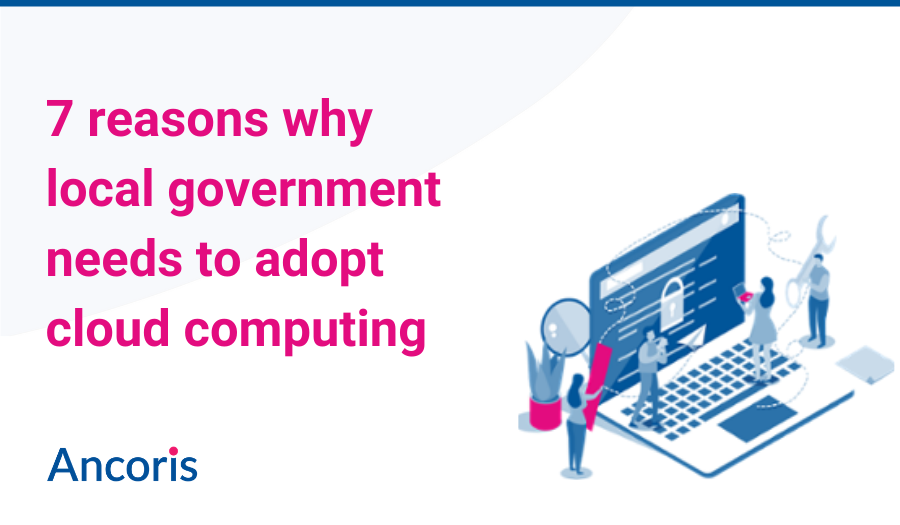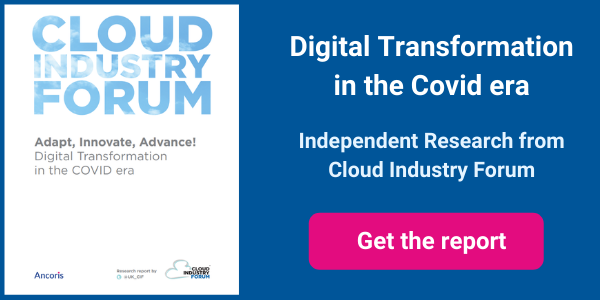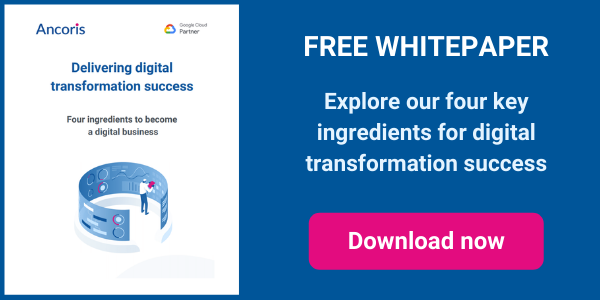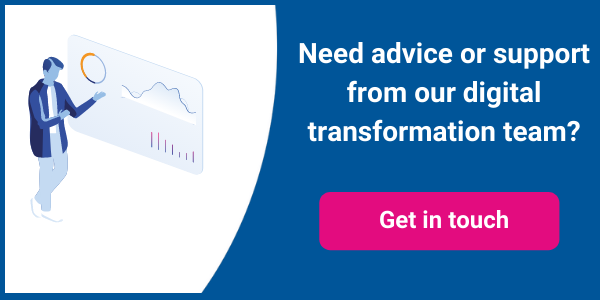Many local authorities are wary of the risk of migrating away from their legacy systems to cloud-based computing. That's not surprising, given the patchy track record of many large-scale public sector IT projects. But cloud adoption and digital transformation will be key to public sector success in the long-term.
As Matt Prosser, policy spokesperson for digital leadership at the Society of Local Authority Chief Executives (SOLACE), has pointed out, legacy-style IT can take three or four years to install – and by the time it's in place, the needs of customers have changed.
The Covid 19 pandemic demonstrated all too clearly the existing truth that the public sector needs systems which are more responsive and agile than most of today’s legacy systems. Challenges included allowing staff to:
- quickly switch to working from different locations
- be able to provide more services digitally rather than face to face
- and handle rapid growth in demand for services as more people faced financial hardship or needed other kinds of support.
Transformation Strategies
The Government Transformation Strategy which ran from 2016 to 2020 demanded the public sector adopted more flexible systems, but it’s estimated that 45% of government IT still runs on legacy infrastructure. A new government Digital Strategy, delayed from last year, is expected to be launched this autumn, while many parts of the public sector will need to rework their IT to handle the (as yet unknown) operational changes flowing from the proposed reorganisation of health and social care services.
Meanwhile, public sector organisations have an obligation to play their part in delivering against government strategies such as the target for the UK to become carbon free by 2050. Of course, many organisations have their own objectives for delivering services in a more sustainable fashion.
In addition, as more services move online, even as cybercrime is on the increase and hackers are mounting ever more sophisticated attacks, the public sector needs to improve its security and data protection measures. Finally, there’s the ever-present issue of meeting increased demand for services with budgets that aren’t growing at the same rate. IT needs to step up in two ways: it needs to reduce its own costs and help deliver the operational transformation that will allow organisations to deliver the same — or improved — services for less.
That's where cloud comes in. Here are 7 ways cloud-based systems such as Google Workspace can help you address these challenges:
1. Enhanced mobility
Google Workspace runs in the browser, so you can work securely from anywhere on any device. The London Borough of Hackney rolled out Google Workspace to Members, officers and partners in 2018 to give them modern and flexible tools that let them work and collaborate seamlessly, from anywhere at any time using any device. When the UK went into lockdown in March 2020, the council’s 4000 staff were able to start working remotely within the space of a week thanks to its cloud-based infrastructure.
2. Improved agility
Collaboration tools in Google Workspace let people work together more effectively in fast-changing situations. Business users can also use tools like Forms and Sites to create simple solutions to support new workflows without any coding skills. That allows you to make changes as often as necessary – and roll those changes out in weeks rather than years – as services are reshaped to match changing needs.
There was certainly no greater need to reshape services than when the Covid 19 pandemic turned the world on its head. At the London Borough of Hackney, staff were able to use the tools in Google Workspace to quickly complete the daily situation reports and other documents that were helping the council keep track of its services and the community. As new challenges emerged, Google Workspace helped the council eliminate departmental silos, allowing staff from different departments to jump on to Google Meet calls to sort issues out quickly as a group, instead of having to have several separate conversations.
3. Increased efficiency
Google Workspace is designed to improve team working and eliminate repetitive and routine tasks. For example, with Google Workspace in place, staff at housing association Valleys 2 Coast are able to produce quality work more quickly and efficiently. It’s easier to get more people involved — and involved earlier — when creating and reviewing documents. There’s also no longer any need to spend time on version control or collating feedback, because everyone is always accessing, editing and commenting on the same copy of the document.
Meanwhile, Citizens Advice Manchester is considering how to use Google Meet and Meet Hardware to allow its advisers to see more clients. The advice service turned to Meet at the start of UK lockdown when it could no longer see clients face to face. It installed Meet hardware in partner venues, such as Sure Start Centres, that were still open for in-person visits.
Clients can now enter the room where the Meet hardware is installed at the start of their appointment and, with a single touch, connect to an advisor working from home. Not only does this allow Citizens Advice Manchester to continue to support vulnerable and digitally disadvantages clients but it eliminates the time advisers would spend travelling to partner venues — which can be up to 45 minutes each way — allowing advisers to work with more clients during each session.
4. Improved security
Cloud providers can afford to employ large, dedicated security teams who are entirely focused on monitoring for suspicious activity, responding to threats and performing routine security evaluations and audits. This means cloud solutions are often more secure than their on-prem equivalents.
With Google Workspace, you also benefit from access and privacy controls that give you tight control over who can see and share your data, as well as admin tools to help you manage user accounts and keep end-user devices secure.
Google Workspace can also be a starting point for implementing single sign-on, so that staff working remotely can use their Google account to securely connect to other applications such as your HR system. The London Borough of Hackney is taking this step to reduce the strain on its own network and on-prem infrastructure caused by a surge of new remote workers all trying to access and authenticate at the same time.
5. Improved scalability and costs that flex with you
Google Workspace and Google Voice are both priced on a per-user basis and you can increase or decrease the number of users each month. For Citizens Advice Manchester, which often receives grants to run projects that last just 6 or 12 months, this means they’re no longer tied into paying for user licences long after a project is over. The IT team can also now get new staff set up with email, office applications, video conferencing and even a telephone number in minutes, rather than having to put in an order to their telephony provider and wait several days.
6. Migration at a pace you can handle
Moving to the cloud doesn't have to be all-or-nothing. You can introduce cloud-based solutions alongside legacy IT, especially when it comes to team productivity tools like Google Workspace. With Google Cloud Platform, you can also move legacy systems into the cloud without changing a line of code. That way, you can immediately start enjoying some of the benefits of cloud without the disruption of implementing a whole new IT system.
7. Support for your sustainability agenda
Google Workspace includes tools that let you work in “greener” ways. Google Meet lets people get together face to face without the fuel costs of travelling, while online document creation and editing typically results in lower printing and stationery costs. Citizens Advice Manchester, for example, expects to reduce its costs in this area by half after rolling out Google Workspace.
With Google, you’ll also be running your IT workload in data centres that are 50% more energy efficient than average and which are largely powered by renewable energy.
One final thought to consider is the risk created by sticking with legacy systems for too long. The recent Hafnium hack, which exposed hundreds of thousands of on-prem Exchange Server installations to attack, shows just one of the dangers. So you should be thinking right now about how to move to cloud-based systems, rather than waiting for contracts for legacy systems to expire.
Of course, any change to your IT carries some risk, but moving to the cloud doesn’t have to be a high-risk step. Google cloud partners like Ancoris have already helped public sector organisations like the London Borough of Hackney, Citizens Advice Manchester and Valleys 2 Coast take a low-risk approach to transforming their operations with cloud-based IT.
Working with our digital transformation specialists
If you're involved in the busy day to day and your teams have been working with a process a certain way for years, it can be hard to step back to imagine doing it in a totally different way.
Got an idea to transform your business and want help bringing it to life? We’re all ears. We design, build and manage customised mobile and cloud apps to meet your specific needs – either alongside your team or for you. Our early prowess in mastering APIs led to Google itself becoming a customer and us building their Exam Platform. So not only do we know our onions but you can trust us to deliver innovation and edge in spades.
If you’d like to find out more about how we can help you with your own digital transformation journey, why not take a look at some of our customer success stories or browse our resources. Needless to say, please get in touch with our team if you'd like more practical support and guidance.
Article updated April 2021
First published May 2018



